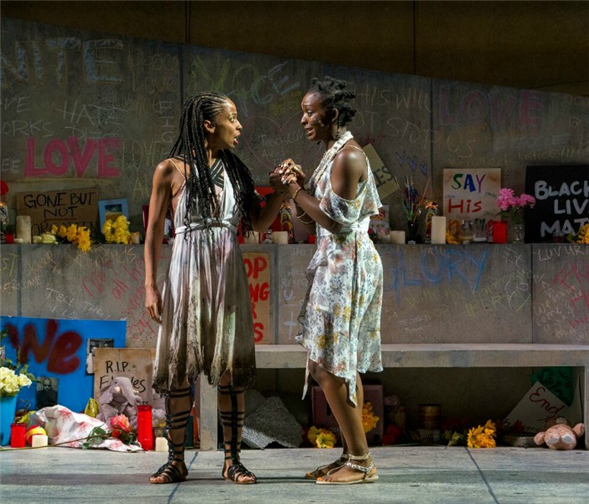Translate Page

How Lex Liang transports Antigone into the future through costumes
---
Lex Liang had never seen a production of Antigone when director Carl Cofield invited him to design the costumes for the Classical Theatre of Harlem's take on Sophocles' tragedy. That was probably a good thing since this is far from a traditional mounting. The company's politically charged, Afropunk-styled staging in Marcus Garvey Park is set in a dystopian future, yet Liang believes it totally speaks to the here and now.
"It is a really important classic to revisit in this time in terms of its feminism, in terms of doing what is morally right, in terms of its relationship to the Black Lives Movement," says Liang about the play, which chronicles the title character's quest to bury her deceased brother against the orders of King Creon.
Set free from designing for any specific era, Liang decided to do a bit of virtual time traveling for inspiration. He looked back at classical Greek clothing, but also tried to imagine what young people of color might be wearing a few decades from now. He was especially interested in how cultural pride and civil rights would be reflected in the fashion of the future.
{Image1}
"Looking at how trends have evolved over the last 30 to 40 years, contemporary clothes haven't changed that much," Liang says. "But how will clothes be affected by current political rhetoric?" He points to the character of Haemon, who's Creon's son and Antigone's fiancée. In this production, "he is a young black man in a hoodie, but that hoodie is mesh, and we incorporated a chain mail effect," Liang says. "If our current racial climate continues, young black men will have to start wearing armor to walk down the street."
The designs also reflect the tribal nature of the tale, as the House of Creon and the House of Oedipus are outfitted in different tones and textures. Liang used a palette of black and gold for the House of Creon and accessorized the costumes with chains, a powerful symbol. But he put Antigone and her sister Ismene in looser, lighter clothing, with gladiator sandals and head scarves. "Antigone breaks the rules because she is doing what is right, so she is not confined to the strictures of law and order," explains Liang. "I really wanted that to come out in the dress."
{Image2}
Liang acknowledges that crafting costumes for an outdoor production during the dog days of summer presents some unique challenges. It's the main reason he went with lightweight, flowing fabrics -- although he also thinks that's what people will be wearing in the future due to climate change. But he loves seeing the costumes in action on the alfresco stage. "These beautiful silk fabrics, chiffons and light linens move so beautifully and take on their own sort of life -- whether that is Creon's cape or Antigone's dress," he observes.
This is Liang's first production with the Classical Theatre of Harlem, and he's enjoyed working with the creative team to conjure this future-past world. He notes how lighting designer Alan C. Edwards "understands how to light fabric and clothing to get the most out of them," and the way choreographer Tiffany Rea-Fisher devised lifts and jumps for the dancing Greek chorus that enhanced the way the fabric tied to their legs elongated the lines of their bodies. The end result, Liang says, "is a testament to all of the designers on the team, who were phenomenal collaborators and incredibly talented in their own right."
To read about a student's experience at Classical Theatre of Harlem's Antigone, check out this post on TDF's sister site SEEN.
---
Allison Considine is a staff writer at American Theatre magazine. Follow her at @theatric_ally. Follow TDF at @TDFNYC.
Top image: Alexandria King and Ava McCoy in Antigone. Photos by Richard Termine.
TDF MEMBERS: Go here to browse our latest discounts for dance, theatre and concerts.